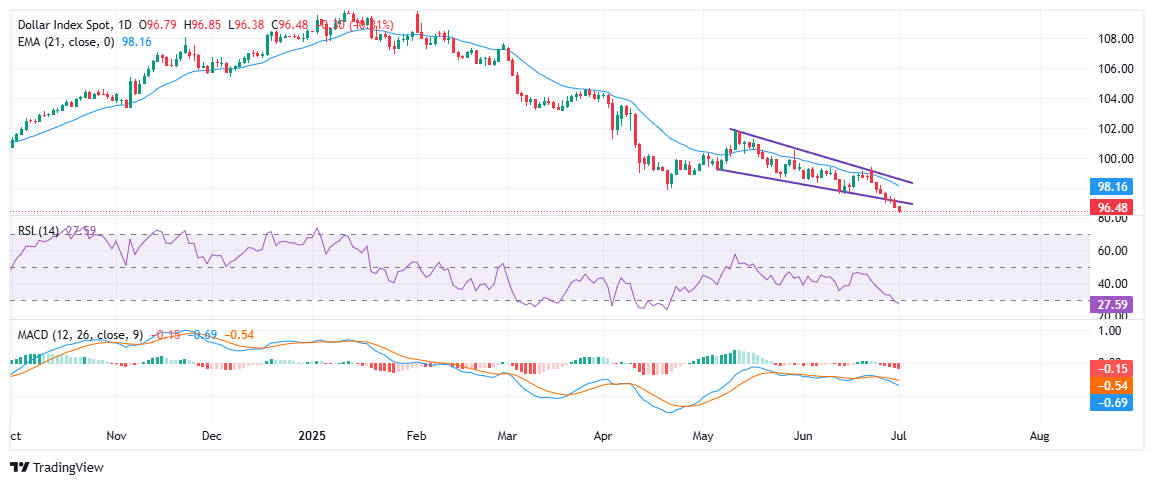Created
: 2025.07.01













![]() 2025.07.01 21:52
2025.07.01 21:52
The US Dollar (USD) continues to face selling pressure, with the US Dollar Index (DXY) currently trading around 96.45, its lowest level since February 2022, as it continues its descent for the ninth straight day. Persistent concerns over US fiscal stability, tariff tensions, and political pressure on the Federal Reserve (Fed) are keeping the Greenback on the back foot.
The DXY has now ended the last six consecutive months in the red, declining over 10% in the first half of 2025 -- its worst first-half performance since currencies began floating in 1973, with the second quarter alone marking its steepest quarterly drop since Q4 2022. The US Dollar weakened against all major G10 currencies during this period as investors sold off dollar-denominated assets.
Multiple key factors have driven the US Dollar's sharp decline over the past quarter, but the Greenback's weakness is primarily due to the unpredictable trade and economic policies of US President Donald Trump. His massive tax-and-spending proposal, known as the "One Big Beautiful Bill," has made investors nervous. The bill, which includes permanent tax cuts and deep spending overhauls, is fueling concerns about fiscal instability and could add more than $3.3 trillion to the national debt.
Adding to the pressure, with the July 9 deadline looming, Trump's push for sweeping tariffs is adding to uncertainty around global trade and economic policy. With less than a week to go, only a tentative agreement with the UK and a de-escalation with China have been reached, while talks with other key trading partners remain stalled. The US administration also appears to be retreating from its idea of "90 trade deals in 90 days". Rather than securing comprehensive trade deals, the focus now seems to be shifting toward interim agreements, while retaining a 10% import tax that ultimately falls on US consumers.

The US Dollar Index (DXY) continues to trade under sustained bearish pressure, recently breaking below the lower boundary of a descending wedge pattern that has guided price action since mid-May. The index is now hovering around 96.45, its lowest level since February 2022, and remains well below the 21-day Exponential Moving Average (EMA), currently at 98.16. This consistent rejection from the EMA highlights the strength of the prevailing downtrend. The breakdown from the wedge suggests a possible acceleration in bearish pressure, with no immediate signs of a reversal.
Momentum indicators further confirm the negative outlook. The Relative Strength Index (RSI) has dropped to 27.59, entering oversold territory, which could signal a potential short-term bounce, although it may also reflect the intensity of the current selling pressure. Meanwhile, the Moving Average Convergence Divergence (MACD) histogram remains in negative territory, with the MACD line widening below the signal line, reinforcing the bearish trend. Unless DXY can reclaim and hold above the 98.00-97.80 zone, the path of least resistance remains to the downside, with eyes now on the next key support around the 96.00 round level.
The table below shows the percentage change of US Dollar (USD) against listed major currencies today. US Dollar was the strongest against the Canadian Dollar.
| USD | EUR | GBP | JPY | CAD | AUD | NZD | CHF | |
|---|---|---|---|---|---|---|---|---|
| USD | -0.15% | -0.11% | -0.72% | 0.12% | 0.00% | -0.20% | -0.40% | |
| EUR | 0.15% | 0.06% | -0.66% | 0.27% | 0.25% | -0.06% | -0.24% | |
| GBP | 0.11% | -0.06% | -0.59% | 0.24% | 0.20% | -0.11% | -0.28% | |
| JPY | 0.72% | 0.66% | 0.59% | 0.89% | 0.73% | 0.51% | 0.33% | |
| CAD | -0.12% | -0.27% | -0.24% | -0.89% | -0.12% | -0.35% | -0.53% | |
| AUD | -0.01% | -0.25% | -0.20% | -0.73% | 0.12% | -0.30% | -0.49% | |
| NZD | 0.20% | 0.06% | 0.11% | -0.51% | 0.35% | 0.30% | -0.18% | |
| CHF | 0.40% | 0.24% | 0.28% | -0.33% | 0.53% | 0.49% | 0.18% |
The heat map shows percentage changes of major currencies against each other. The base currency is picked from the left column, while the quote currency is picked from the top row. For example, if you pick the US Dollar from the left column and move along the horizontal line to the Japanese Yen, the percentage change displayed in the box will represent USD (base)/JPY (quote).
![]()
Created
: 2025.07.01
![]()
Last updated
: 2025.07.01

FXStreet is a forex information website, delivering market analysis and news articles 24/7.
It features a number of articles contributed by well-known analysts, in addition to the ones by its editorial team.
Founded in 2000 by Francesc Riverola, a Spanish economist, it has grown to become a world-renowned information website.
We hope you find this article useful. Any comments or suggestions will be greatly appreciated.
We are also looking for writers with extensive experience in forex and crypto to join us.
please contact us at [email protected].
Disclaimer:
All information and content provided on this website is provided for informational purposes only and is not intended to solicit any investment. Although all efforts are made in order to ensure that the information is correct, no guarantee is provided for the accuracy of any content on this website. Any decision made shall be the responsibility of the investor and Myforex does not take any responsibility whatsoever regarding the use of any information provided herein.
The content provided on this website belongs to Myforex and, where stated, the relevant licensors. All rights are reserved by Myforex and the relevant licensors, and no content of this website, whether in full or in part, shall be copied or displayed elsewhere without the explicit written permission of the relevant copyright holder. If you wish to use any part of the content provided on this website, please ensure that you contact Myforex.
Myforex uses cookies to improve the convenience and functionality of this website. This website may include cookies not only by us but also by third parties (advertisers, log analysts, etc.) for the purpose of tracking the activities of users. Cookie policy